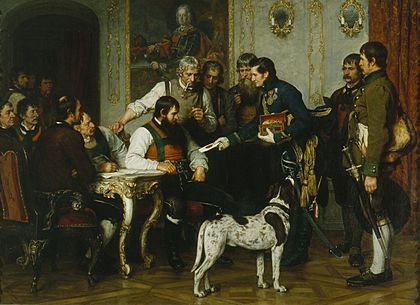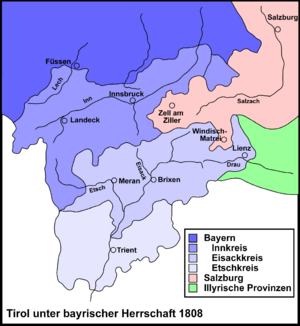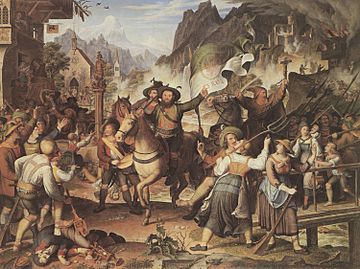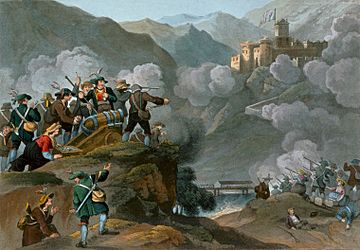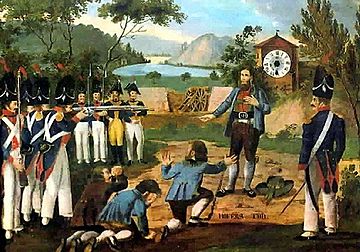Tyrolean Rebellion facts for kids
Quick facts for kids Tyrolean Rebellion |
|||||||
|---|---|---|---|---|---|---|---|
| Part of the War of the Fifth Coalition | |||||||
 Homecoming of Tyrolean Militia by Franz Defregger |
|||||||
|
|||||||
| Belligerents | |||||||
|
|
|||||||
| Commanders and leaders | |||||||
|
|||||||
| Strength | |||||||
| 40,000 | 80,000 | ||||||
| Casualties and losses | |||||||
| 5,000 | 12,250 | ||||||
The Tyrolean Rebellion (German: Tiroler Volksaufstand) was a fight for freedom. It happened in 1809 in a region called Tyrol. People like farmers, craftspeople, and other civilians stood up against new laws. They were led by Andreas Hofer. This rebellion was part of a bigger war called the War of the Fifth Coalition.
Contents
Why Did the Tyroleans Rebel?
Tyrol Changes Hands
For a long time, Tyrol was part of the Habsburg monarchy (Austria). But in 1805, things changed. Bavaria, a German state, joined forces with Napoleon I of France. After a war, Napoleon defeated Austria. As a result, Tyrol was given to Bavaria. This happened in 1806.
New Rules and Unhappiness
The new Bavarian government brought many changes to Tyrol. These changes made the Tyrolean people very unhappy.
- They changed old rules and the school system.
- They took away the Tyroleans' right to defend themselves.
- Taxes went up, and people couldn't sell their goods easily.
- The government also interfered with church traditions. They banned holidays and church bell ringing. These were important parts of Tyrolean culture.
- Tyrol was split into three new districts.
- The new rules meant Tyroleans had to join the Bavarian army. They could be sent to fight far from home. This was a big problem because many soldiers died in Napoleon's wars.
- A new rule made smallpox vaccination mandatory. Many Tyroleans saw this as wrong.
All these changes led to a lot of anger and eventually, a revolt.
The Rebellion Begins
First Sparks of Revolt
The rebellion started when young men in a town called Axams refused to join the Bavarian army. They fled to Innsbruck. These young men kept in touch with Austria, hoping for help.
On April 9, 1809, Austria declared war on France and Bavaria. Austria said that Bavaria had broken promises about Tyrol's freedom. So, any resistance against Bavaria was right.
Early Battles
An Austrian army tried to help the Tyroleans. But they were defeated by Bavarian and French troops near Wörgl.
Meanwhile, Tyrolean civilians, led by Andreas Hofer, gathered. Hofer was an innkeeper and merchant. His army of "Schützen" (citizen militia) marched north. They built roadblocks at important places like the Brenner Pass.
The Tyroleans fought bravely in the First and Second Battles of Bergisel near Innsbruck. They managed to push back the Bavarian forces.
Fighting Alone
The Tyroleans were happy when they heard Napoleon lost a battle in May. But then, Napoleon won another big battle in July. Austria signed a peace agreement and pulled its troops out of Tyrol.
This left the Tyrolean rebels to fight alone. But they kept winning battles against the French and Bavarians. After the Third Battle of Bergisel in August, the French had to retreat. Hofer took charge of the free areas in Innsbruck. Tyrol had a short time of independence.
However, in October, Austria officially gave up its claim to Tyrol. Napoleon ordered his army to take back the region. French and Bavarian forces, under new commanders, fought the remaining Tyrolean troops. The Fourth Battle of Bergisel on November 1 finally crushed the rebellion.
What Happened Next?
Hofer's Capture and Death
Many Tyrolean fighters were killed after the rebellion ended. Andreas Hofer, the leader, hid in the mountains. But he was betrayed in January 1810. He was arrested and taken to Mantua.
Napoleon himself ordered Hofer's death. Hofer was executed on February 20, 1810. His body was later moved to Innsbruck in 1823.
Tyrol Reunited
After Napoleon's defeat in 1814, things changed again. At a big meeting called the Congress of Vienna, all parts of Tyrol were reunited. They became part of Austria once more.
Hofer's Legacy
Andreas Hofer became a hero in Tyrol. His story of fighting for freedom against Napoleon became a big part of Tyrolean history. A song about his execution, "Zu Mantua in Banden", became the official anthem of the Austrian state of Tyrol in 1948.
Hofer's life has been shown in movies and documentaries. He is remembered as a brave leader who fought for his people's rights.


